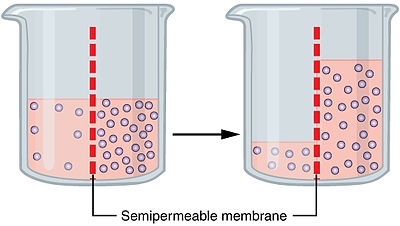A sample of seaweed contains two liters of water and has 100 grams of salt dissolved in its cells. The seaweed is placed in a bucket with 4 liters of water and 300 grams of dissolved salt. What will occur when the system reaches equilibrium?
1 Answer
The seaweed must lose
Explanation:
This is a great example of how an osmosis problem would look like.
However, you don't actually have to use the concept of osmosis to solve this one. Here's why I say that.
So, you know that your seaweed contains
The first thing to notice here is that initially, the volume of water in the bucket in twice as large as the volume of water in the seaweed.
#V_"water b" = 2 xx V_"water sw"#
Now, when equilibrium is established, the volume of water in the seaweed will be
This means that you can say
#100/x = 300/y implies y = 3x#
So at equilibrium, the volume ratio between the volume of water in the bucket and the volume of water in the seaweed has increased. This means that the seaweed lost water to its surroundings, i.e. to the bucket.
If
#overbrace((4 + z))^(color(red)("water in the bucket")) = 3 xx overbrace((2 - z))^(color(blue)("water in the seaweed"))#
Solve this for
#4 + z = 6 - 3z#
#4z = 2 implies z = 2/4 = "0.5 L"#
Therefore, the seaweed lost
Now, let's see if our knowledge of how osmosis works can confirm this result.
As you know, osmosis is defined as the movement of solvent molecules through a semi-permeable membrane from a region of lower solute concentration to a region of higher solute concentration.

The initial concentrations of salt in the seaweed and in the bucket are
#"100 g"/"2 L" = "50 g/L" -># in the seaweed
#"300 g"/"4 L" = "75 g/L" -> # in the bucket
SIDE NOTE You can convert these concentrations into percent concentrations by mass or into mass by volume percent concentrations if you want, the result will be the same.
So, the bucket has a higher concentration of solute than the seaweed. This tells you that when osmosis kicks in, the seaweed will lose water.
From this point on, the calculations are exactly the same. If
#100/(2-z) = 300/(4 + z)#
Solve this for
#100 * (4 + z) = 300 * (2- z)#
#400 + 100z = 600 - 300z#
#400z = 200 implies z = 200/400 = 0.5#
The first result is confirmed - in order for equilibrium to be obtained, the seaweed must lose

